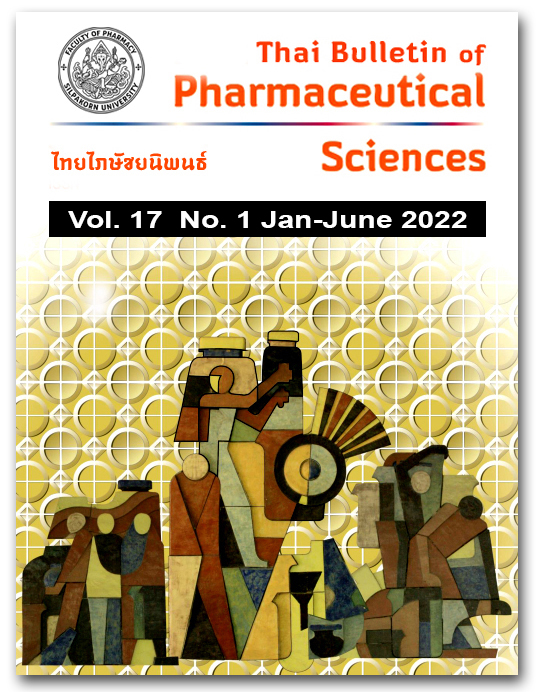ปัจจัยที่มีความสัมพันธ์ต่อพฤติกรรมการใช้ฟ้าทะลายโจรในการดูแลสุขภาพ ช่วงภาวะติดเชื้อโควิด-19 ของประชาชนในอำเภอหาดใหญ่ จังหวัดสงขลา
DOI:
https://doi.org/10.69598/tbps.17.1.57-69คำสำคัญ:
โควิด-19, ฟ้าทะลายโจร, พฤติกรรมการใช้สมุนไพร, การดูแลตนเองบทคัดย่อ
ปัจจุบันมีการใช้สมุนไพรเพื่อการดูแลตนเองอย่างแพร่หลาย โดยเฉพาะในภาวะการติดเชื้อโควิด-19 ประชาชนมีการใช้ฟ้าทะลายโจรในการบรรเทาอาการเบื้องต้นมากขึ้น การศึกษานี้มีวัตถุประสงค์เพื่อศึกษาพฤติกรรมและปัจจัยที่มีความสัมพันธ์ต่อการใช้ฟ้าทะลายโจรในการดูแลสุขภาพตนเองที่เพิ่มขึ้นในช่วงภาวะโรคติดเชื้อโควิด-19 ของประชาชนในอำเภอหาดใหญ่ จังหวัดสงขลา ดำเนินการเก็บข้อมูลจากกลุ่มตัวอย่างจำนวน 432 คน ระหว่างเดือนธันวาคม 2563 ถึงเดือนมกราคม 2564 โดยใช้แบบสอบถามที่พัฒนาขึ้นตามแนวคิดแบบแผนความเชื่อด้านสุขภาพและทฤษฎีพฤติกรรมตามแผน วิเคราะห์ข้อมูลโดยใช้สถิติเชิงพรรณนาและสถิติการถดถอยโลจิสติกพหุตัวแปร จากการศึกษาพบว่า ในช่วงของการระบาดของเชื้อโควิด-19 กลุ่มตัวอย่างร้อยละ 17.82 มีความถี่ในการใช้ฟ้าทะลายโจรเพิ่มขึ้นเมื่อเทียบกับก่อนการระบาด โดยส่วนใหญ่ใช้รูปแบบของฟ้าทะลายโจรแคปซูล รองลงมาคือต้นสด ปัจจัยที่มีความสัมพันธ์กับพฤติกรรมการใช้ฟ้าทะลายโจรที่มีความถี่เพิ่มขึ้นอย่างมีนัยสำคัญทางสถิติเมื่อควบคุมอิทธิพลของตัวแปรกวน คือ ปัจจัยด้านช่วงอายุ 40-59 ปี (Adjusted OR = 1.96, 95%CI: 1.06-3.64) ปัจจัยด้านการมีอาการไข้ ไอ เจ็บคอในช่วงที่มีการระบาดของเชื้อโควิด-19 (Adjusted OR = 6.11, 95%CI: 3.38-11.04) ปัจจัยการรับรู้ความรุนแรงของการติดเชื้อโควิด-19 (Adjusted OR = 1.16, 95%CI: 1.05-1.27) และปัจจัยการคล้อยตามกลุ่มอ้างอิง (Adjusted OR = 1.07, 95%CI: 1.00-1.14) ดังนั้น บุคลากรทางการแพทย์ควรมีการส่งเสริมความเข้าใจและวิธีการใช้ฟ้าทะลายโจรที่ถูกต้อง อีกทั้งควรมีกลยุทธ์การสื่อสารสุขภาพที่มีประสิทธิภาพเพื่อให้ประชาชนลดความกังวลต่อสถานการณ์ของโรคระบาด
เอกสารอ้างอิง
World Health Organization. Statement on the second meeting of the International Health Regulations (2005) Emergency Committee regarding the outbreak of novel coronavirus (2019-nCoV) [Internet]. [cited 2021 June 21]. Available form: https://www.who.int/news-room/detail/ 30-01-2020-statementon-the-second-meeting-of-the-international-health-regulations-(2005)-emergency-committee-regarding-the-outbreak-of-novelcoronavirus-(2019-ncov).
Tuicharoen J, Wongprakhob N, Munsraket K, Nimkratoke T. Management of the COVID-19 in primary health care settings. J Health Sci BCNSP. 2020;2(3):1-20. (in Thai)
Singhal T. A review of coronavirus disease-2019 (COVID-19). Indian Pediatr. 2020;87(4):281-6.
Amawi H, Abu Deiab GA, A Aljabali AA, Dua K, Tambuwala MM. COVID-19 pandemic: an overview of epidemiology, pathogenesis, diagnostics and potential vaccines and therapeutics. Ther Deliv. 2020;11(4):245-68.
Umakanthan S, Sahu P, Ranade AV, Bukelo MM, Rao JS, Abrahao-Machado LF, et al. Origin, transmission, diagnosis and management of coronavirus disease 2019 (COVID-19). Postgrad Med J. 2020;96(1142):753-8.
Songkhla Provincial Office, Songkhla Provincial Public Health Office. [Internet]. Situation report of COVID-19 in Songkhla. [cited 2021 August 1]. Available form: https://covid.songkhla.go.th (in Thai)
National Drug Committee. National List of Essential Drugs AD 1999 (List of Herbal Medicinal Products). National Essential Drug List Committee, Ministry of Public Health, Bangkok. 1999. (in Thai)
National Drug Committee. List of herbal medicinal products AD 2006. Bangkok: Chuoomnoom Sahakorn Karnkaset Publisher. 2006:59-61. (in Thai)
Hu XY, Wu RH, Logue M, Blondel C, Lai LY, Stuart B, et al. Andrographis paniculata (Chuān Xīn Lián) for symptomatic relief of acute respiratory tract infections in adults and children: A systematic review and meta-analysis. PloS one. 2017;12:e0181780.
Sa-Ngiamsuntorn K, Suksatu A, Pewkliang Y, Thongsri P, Kanjanasirirat P, Manopwisedjaroen S, et al. Anti-SARS-CoV-2 activity of Andrographis paniculata extract and its major component Andrographolide in human lung epithelial cells and cytotoxicity evaluation in major organ cell representatives. J Nat Prod. 2021;84(4):1261-70.
Rattanaraksa D, Khempetch R, Poolwiwatchaikool U, Nimitvilai S, Loatrakul O, Srimanee P. The efficacy and safety of Andrographis paniculate extract for treatment of COVID-19 patients with mild symptoms, Nakhonpathom hospital. Reg 4-5 Med J. 2021;40(2);269-82. (in Thai)
Chatawatee B. Andrographis paniculata with cough. [Internet]. Faculty of Traditional Thai Medicine. Prince of Songkla University. 2019. [cited 2021 June 21]. Available form: https://www.ttmed.psu.ac.th/th/blog/229 (in Thai)
Chaimay P, Boonrod T, Simla W. Factors affecting herbal uses in primary health care. J Public Health of Burapha Univ. 2012;7(2);27-37. (in Thai)
Mueangchang W. Factors related to self treatment with herbal remedies of people in Mea Chai district, Phayao province. Master thesis, M.P.H., Thammasat University. 2016. (in Thai)
Chainorong W. Factors related to using herbs for primary treatment behaviors of people in Thanyaburi district, Pathum Thani province. Master thesis, M.S., Kasetsart University. 2011. (in Thai)
Kengganpanich T, Leerapan P, Kengganpanich M, Nunthasen K, Lattanand K. Factors related to herbal consumption for controlling blood sugar of patients with type 2 diabetes mellitus. JBCN Bangkok. 2015;31(1):13-25. (in Thai)
Srathueng C, Mohamad K, Asae A, Asae K, Kongprasom U. Factor related with people’s behavior towards using medical herbs for wounds treatments among people in sub-district Kradangnga, district Sathingpra, Songkhla province. The 3rd National Conference on Science and Technology of Southern Network. 2018; 976-84. (in Thai)
Taro Yamane. Statistics: an introductory analysis. 3rd ed. New York: Harper and Row Publications; 1973.
Woradet S, Chaimay B, Salaea R, Kongme Y. Factors associated with herbal used behavior towards self care among village health volunteers in Krung La district, Phatthalung province. J Health Sci. 2015;24(1);50-9. (in Thai)
Nakornchaikun K. Marketing factors affecting customer’s behavior of processed herbal products in Ubon Ratchathani. J Manage Sci Ubon Ratchathani Univ. 2017;12(6);28-42. (in Thai)
Deenoo S, Mattavangkul C, Kawitu K, Sinwannakool S. Factor related to herbal use behavior for self-care among people in Phasi-Chareon district. J Nurs Siam Univ. 2019;20(39):99-109. (in Thai)
Wichantuk P. Knowledge, attitude and behavior of herbal medicinal products used among peoples in Nong Bua Sala village, Mueang district, Nakhon Ratchasima province. J Health Sci. 2019;28:244-54. (in Thai)



